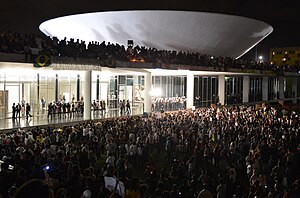| 2013 Brazilian protests | |||
|---|---|---|---|
 Protesters at the National Congress of Brazil, in Brasília, 17 June | |||
| Date | May - June 2013 (minor protests)[a] June – July 2013 (major protests)[b] | ||
| Location | • Over 500 Brazilian cities and at least 27 cities with Brazilian diasporas around the globe | ||
| Caused by | • Increases in bus, train and metro fare in some major cities • Police Brutality • Low quality and insufficient public transport • Multiple issues regarding infrastructure, education and health care among other public services • High cost of living • Increasing government funding of major sports events • Feeling of alienation from government decisions • Multiple scandals of corruption, embezzlement and overbilling in the government • Low investment in public services • Multiple reports of abuse of special benefits conceded to Brazilian politicians • Controversial law in discussion by National Chamber's plans limiting the powers of the Public Ministry to investigate criminal activities, among other reasons | ||
| Goals | • Improvements in public transport's quality and access to the population (subdued 24 June) • Less public transport cost for the population (subdued 24 June) • Increase of government effort and funds to improve other key public services including public education, national health care and transport infrastructure altogether (subdued 24 June) • Less priority to fund major sports events (subdued 24 June) • Revocation of controversial law in discussion by National Chamber's plans limiting the powers of the Public Ministry to investigate criminal activities in the government (subdued 25 June) • "Zero tariffs" • End to police brutality • Democratization of the media | ||
| Methods | • Occupations of public and private buildings, • Autodefense of masses and Black Block, • Demonstrations, • protest marches, • online activism and alternative media, • Direct action, • Graffiti, banners and signs, • Barricades, • attacks to government power and capitalist symbols, • Destruction and firebombing of buses. | ||
| Status | Major protests subsided | ||
| Number | |||
| |||
| Casualties | |||
| Death(s) | 13+ [2] | ||
| Injuries | 100[3] | ||
| Arrested | 250[3] | ||
The 2013 Brazilian protests[c][9] were public demonstrations in several Brazilian cities, initiated mainly by the Movimento Passe Livre (Free Fare Movement), a local entity that advocates for free public transportation.
The demonstrations were initially organized to protest against increases in bus, train, and metro ticket prices in some Brazilian cities,[10][11][12][13] but grew to include other issues such as the high corruption in the government and police brutality used against some demonstrators.[14][15] By mid-June, the movement had grown to become Brazil's largest since the 1992 protests against former President Fernando Collor de Mello.[16]
As with the 2013 Gezi Park protests in Turkey, social media has played an important role in the organization of public outcries and in keeping protesters in touch with one another.[17]
Cite error: There are <ref group=lower-alpha> tags or {{efn}} templates on this page, but the references will not show without a {{reflist|group=lower-alpha}} template or {{notelist}} template (see the help page).
- ^ Watts, Jonathan (21 June 2013). "Brazil protests: president to hold emergency meeting". The Guardian. London.
- ^ "Pelo menos 13 pessoas morreram em um ano de protestos pelo país". 13 June 2014.
- ^ a b Mallén, Patricia Rey (17 June 2013). "Brazil's Protests Get More Violent, Reach Brasilia And Threaten The Confederation Soccer Cup". International Business Times. Retrieved 20 June 2013.
- ^ Cite error: The named reference
Autumnwas invoked but never defined (see the help page). - ^ The Brazilian Spring: An Explainer, ABC, June 24, 2013
- ^ "Comissão de Cultura da Câmara ouve Fora do Eixo e Mídia Ninja". Rede Brasil Atual. Archived from the original on 4 October 2015. Retrieved 2 October 2015.
- ^ "Racha e expulsões no Bloco de Lutas - Rosane de Oliveira". Archived from the original on 4 October 2015. Retrieved 2 October 2015.
- ^ "UJS comemora neste domingo 29 anos de luta". Retrieved 2 October 2015.
- ^ "Protests in Brazil". The Economist. 18 June 2013. Retrieved 2 October 2015.
- ^ Arias, Juan (12 June 2013). "Brasil se levanta en protesta contra el aumento de los precios del transporte". El País (in Spanish). Retrieved 13 June 2013.
- ^ Arias, Juan (14 June 2013). "São Paulo vive una nueva noche de protestas con escenas de guerra". El País (in Spanish). Retrieved 14 June 2013.
- ^ Arias, Juan (14 June 2013). "Brésil: manifestations contre la hausse du prix des transports". Le Monde (in French). Retrieved 14 June 2013.
- ^ Brocchetto, Marilia (12 June 2013). "Protesters, police clash in Sao Paulo streets over fare increases". CNN. Retrieved 13 June 2013.
- ^ Cite error: The named reference
anistiawas invoked but never defined (see the help page). - ^ "Associação de jornais condena ação da PM". Gazeta do Povo (in Portuguese). 14 June 2013. Archived from the original on 7 April 2014. Retrieved 20 June 2013.
- ^ Cite error: The named reference
el paíswas invoked but never defined (see the help page).